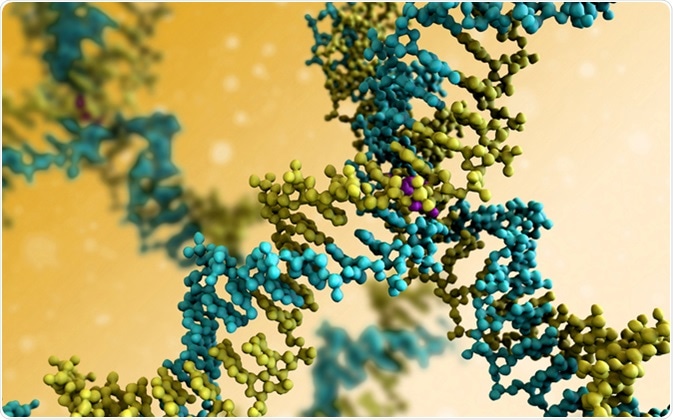Peptide aptamers are small, artificial polypeptides, which bind to target proteins in a highly specific manner, similar to antibodies. These proteins can occur naturally or they may be artificially created.
What are Aptamers?
Aptamers were first used in research following their discovery in the 1990’s when Tuerk and Gold developed a methodology to select for RNA ligands, which bind very specifically to T4 DNA polymerase. The first aptamers designed were the nucleic acids RNA and DNA.
However, in 1996 peptide aptamers were developed. These peptides contain a peptide scaffold bound to a variable loop region (5-20 residues long), which contains different amino acid sequences. This variable loop region has the abilitiy to recognize and bind to sequences, whereas the protein scaffold provides flexibility and prevents abnormal binding by stabilizing the conformation of the loop.
The first protein scaffold was the Escherichia coli thioredoxin. This protein is still used in protein aptamer technology as it contains an active loop site, which can be replaced by a variable sequence.

DNA Molecule Model. Image Credit: UGREEN 3S / Shutterstock
Isolation of Protein Aptamers
Once created, protein aptamers are usually isolated from combinatorial libraries through a selection technique. They are then improved through numerous alterations, mainly through point-mutations.
Selection is usually made by the yeast two-hybrid system, but can also be carried out using phage display and a range of other cell-free processes.
In the yeast two-hybrid system, protein aptamers are prepared and bound to Gal4 activation domains (prey), whilst the target sequences are bound to Gal4 binding domains (bait).
Both the binding and the activation domain are required for transcription of a protein, but a downstream reporter gene may be activated through a transcription factor binding to an upstream activating sequence. Therefore, if a bait protein and the prey protein bind, then these two domains come close enough to interact, and the reporter gene can be transcripted.
However, if these proteins do not interact then no transcription occurs. Therefore, the protein aptamers that lead to transcription of the reporter gene are the proteins that are complementary to the desired sequence.
Alternatively, in the cell-free phage display method, polypeptides are presented on the surface of bacteriophages. These sequences can then select for and bind to polypeptides, which are compatible with the pre-selected sequence.
Roles of Protein Aptamers
In vivo, aptamers naturally bind to their protein target and disrupt their function through a variety of mechanisms, for example, by preventing interactions with other proteins. This property has therefore made these protein aptamers useful in the characterization of proteins. For example, they can be used as mutagens, binding and inhibiting the function of the target gene.
A specific phenotype can then be selected for and this allows the identification of protein aptamers that create this phenotype through inhibiting the protein function. This can, therefore, be used to identify the target protein, its biological role and other interacting proteins.
Protein aptamers have therefore been used in many research fields, for example for the identification of genes, which are involved in the cell cycle.
Further developments have also shown that these aptamers are able to alter the localization of proteins or lead to abnormal posttranslational modifications, making them even more valuable in research.
These proteins can also be applied for in vitro research. They bind to proteins of interest, allowing the identification of a wide variety of polypeptides, such as active isoforms and antibody targets.
Further Reading
Last Updated: Nov 1, 2018